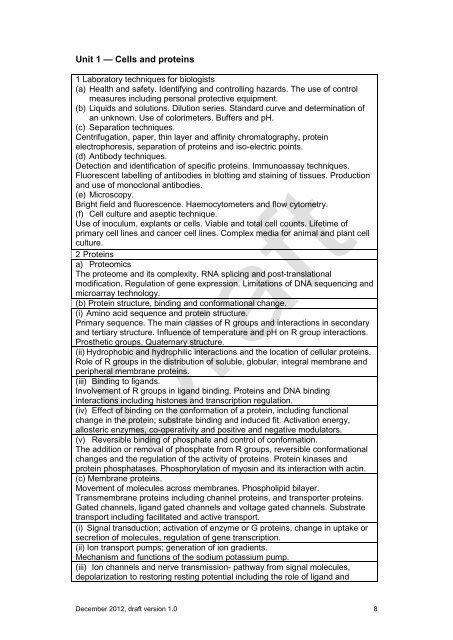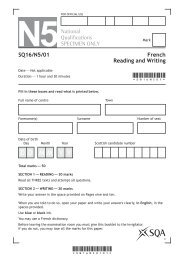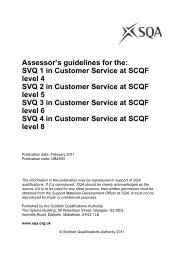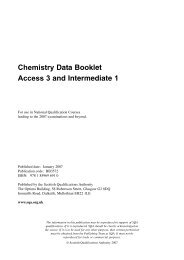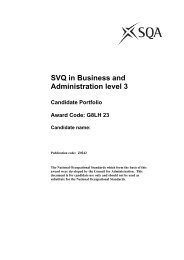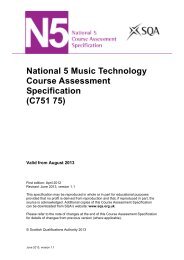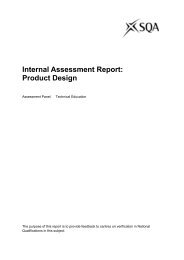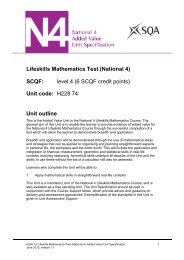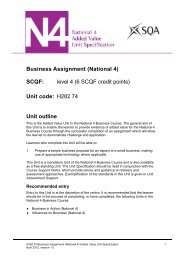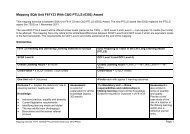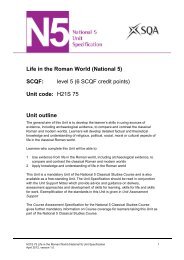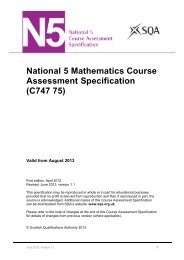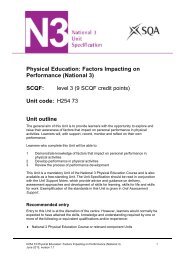Advanced Higher Biology Draft National Course Assessment ...
Advanced Higher Biology Draft National Course Assessment ...
Advanced Higher Biology Draft National Course Assessment ...
Create successful ePaper yourself
Turn your PDF publications into a flip-book with our unique Google optimized e-Paper software.
Unit 1 — Cells and proteins<br />
1 Laboratory techniques for biologists<br />
(a) Health and safety. Identifying and controlling hazards. The use of control<br />
measures including personal protective equipment.<br />
(b) Liquids and solutions. Dilution series. Standard curve and determination of<br />
an unknown. Use of colorimeters. Buffers and pH.<br />
(c) Separation techniques.<br />
Centrifugation, paper, thin layer and affinity chromatography, protein<br />
electrophoresis, separation of proteins and iso-electric points.<br />
(d) Antibody techniques.<br />
Detection and identification of specific proteins. Immunoassay techniques.<br />
Fluorescent labelling of antibodies in blotting and staining of tissues. Production<br />
and use of monoclonal antibodies.<br />
(e) Microscopy.<br />
Bright field and fluorescence. Haemocytometers and flow cytometry.<br />
(f) Cell culture and aseptic technique.<br />
Use of inoculum, explants or cells. Viable and total cell counts. Lifetime of<br />
primary cell lines and cancer cell lines. Complex media for animal and plant cell<br />
culture.<br />
2 Proteins<br />
a) Proteomics<br />
The proteome and its complexity. RNA splicing and post-translational<br />
modification. Regulation of gene expression. Limitations of DNA sequencing and<br />
microarray technology.<br />
(b) Protein structure, binding and conformational change.<br />
(i) Amino acid sequence and protein structure.<br />
Primary sequence. The main classes of R groups and interactions in secondary<br />
and tertiary structure. Influence of temperature and pH on R group interactions.<br />
Prosthetic groups. Quaternary structure.<br />
(ii) Hydrophobic and hydrophilic interactions and the location of cellular proteins.<br />
Role of R groups in the distribution of soluble, globular, integral membrane and<br />
peripheral membrane proteins.<br />
(iii) Binding to ligands.<br />
Involvement of R groups in ligand binding. Proteins and DNA binding<br />
interactions including histones and transcription regulation.<br />
(iv) Effect of binding on the conformation of a protein, including functional<br />
change in the protein; substrate binding and induced fit. Activation energy,<br />
allosteric enzymes, co-operativity and positive and negative modulators.<br />
(v) Reversible binding of phosphate and control of conformation.<br />
The addition or removal of phosphate from R groups, reversible conformational<br />
changes and the regulation of the activity of proteins. Protein kinases and<br />
protein phosphatases. Phosphorylation of myosin and its interaction with actin.<br />
(c) Membrane proteins.<br />
Movement of molecules across membranes. Phospholipid bilayer.<br />
Transmembrane proteins including channel proteins, and transporter proteins.<br />
Gated channels, ligand gated channels and voltage gated channels. Substrate<br />
transport including facilitated and active transport.<br />
(i) Signal transduction; activation of enzyme or G proteins, change in uptake or<br />
secretion of molecules, regulation of gene transcription.<br />
(ii) Ion transport pumps; generation of ion gradients.<br />
Mechanism and functions of the sodium potassium pump.<br />
(iii) Ion channels and nerve transmission- pathway from signal molecules,<br />
depolarization to restoring resting potential including the role of ligand and<br />
December 2012, draft version 1.0 8


